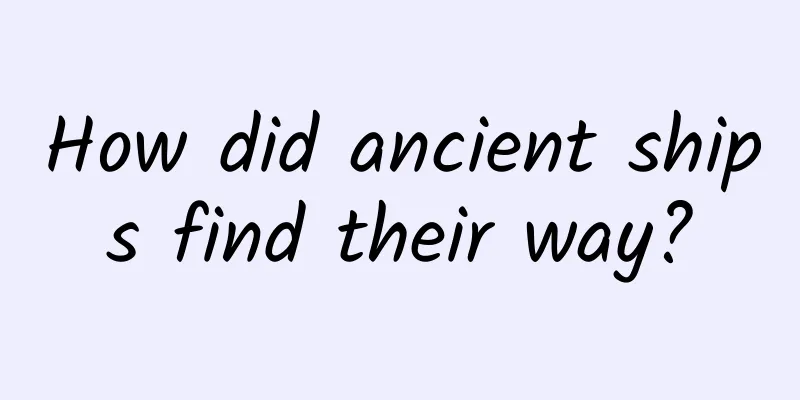How did ancient ships find their way?

|
How to find ancient ships Direction of travel? With the development of technology, navigation has become an indispensable tool for people to go out. No need to ask for directions, just with navigation in hand, you can travel around the world. Navigation has provided great convenience for people's lives, but in ancient times when there was no navigation, how did people identify the position and direction? Ancient Navigation As early as the Warring States Period more than 2,000 years ago, the wise ancient people had discovered that magnets have the ability to point to polarity. So they used the polarity of magnets to invent the Si Nan. Guiguzi wrote: "When the people of Zheng go to get jade, they must carry the Si Nan cart with them, so that they will not get lost." From the records in the classics, we can also see that the Si Nan played an indispensable role in the travel of ancient people. Sinan Si Nan was continuously improved by humans, and one of the four great inventions of ancient China, the compass, appeared. The appearance of the compass was not achieved overnight, but after a very long period of improvement. The improved works of Si Nan, the compass fish and the floating magnetic needle, were mainly recorded in the Tang and Song dynasties. For example, the "Shen Ji Secret Book" said: "The needle method was not passed down in ancient times, and it was first made by Xuan Zhen in ancient times." Xuan Zhen was a Tang Dynasty person who was good at physics. The preparation method of the compass fish was recorded in "Wu Jing Zong Yao". The book said: "Use thin iron leaves to cut, two inches long and five points wide, with sharp heads and tails like fish shapes, put them in charcoal fire and burn them. When they are red, use an iron seal to seal the fish head out of the fire, and put the tail directly in the position of the child. Dip it in a basin of water and stop when the tail is submerged for several minutes, and collect it in a sealed container." This book was written in the Northern Song Dynasty. Compass fish The floating magnetic needle was also recorded in the Northern Song Dynasty. It was specifically recorded in the masterpiece of the famous scientist Shen Kuo, Mengxi Bitan. In Volume 24, it says: "The experts rubbed the needle tip with a magnet and it could point south." Floating magnetic needle Compared with on land, humans are more likely to get lost when sailing, and the compass at this time cannot fully meet the navigation needs. In this situation, humans invented more tools that can indicate direction during sailing, and these tools helped humans embark on the great road of navigation. Getting lost during a voyage is extremely dangerous. Faxian, a monk from the Eastern Jin Dynasty, once wrote: "The sea is boundless and I cannot tell east from west. I can only look to the sun, the moon and the stars to move forward." This shows that in addition to using geomagnetic navigation, the ancients also used the laws of astronomy for navigation. Among them, the most famous astronomical navigation tool is the star-guiding board that accompanied Zheng He on his seven voyages to the West. The star-pulling board is a tool used in ancient my country to carry out navigation and navigation using astronomical positioning technology - star-pulling. Its main principle is to convert the vertical height measured by the star-pulling board and the length of the fiber rope to calculate the altitude angle of the North Star, and then determine the geographical latitude of the location. Star Puller Board Twenty pages of Zheng He's nautical charts are preserved in "Wubeizhi", four of which are "Star-Guiding Charts for Crossing the Ocean". The observation instruments used by the crew in the charts are star-guiding boards. Crossing the Ocean to Pull the Stars According to records, the star-pulling board is composed of 12 pieces of ebony boards with scales and sides ranging from 2 to 24 cm. The observer needs to hold the star-pulling board so that the board surface is perpendicular to the sea level, the lower edge is perpendicular to the sea-sky boundary, and the upper edge is connected to the celestial body to be measured. A long rope is drawn on the board to fix the distance between the star-pulling board and the observer's eyes. The calculation units are "finger" and "angle". One finger is about 1.9° today, which is equivalent to four angles. In the Marine Astronomy Exhibition Hall of the National Maritime Museum, there is an interactive screen for experiencing the principle of the star-pulling board. Interactive experience screen in the Marine Astronomy Exhibition Hall of the Marine Museum In the West, there is also a sextant used to measure stars for navigation. The principle of the sextant is very simple, that is, the reflection angle of light is equal to the incident angle. When using it, the observer needs to hold the sextant and rotate the index mirror so that the celestial body that appears in the field of view coincides with the sea level. The altitude angle of the celestial body can be read according to the rotation angle of the index mirror, and the error is about ±0.2°~±1°. Interactive experience screen in the Marine Astronomy Exhibition Hall of the Marine Museum The principle of the sextant was proposed by Newton. In 1732, the British Navy began to install the original instrument on ships. Because the maximum measuring angle at that time was 90 degrees, it was called an octant. In 1757, Captain John Campbell increased the measuring angle of the octant to 120 degrees, and developed it into a sextant. Although the measuring angle of the sextant was gradually increased to 144 degrees, its name remained unchanged. The crystal decoration above the entrance to the Marine Astronomy Exhibition Hall of the National Museum of Marine Life is in the shape of a sextant. Marine Astronomy Hall Entrance sextant decoration In addition, the Jingtianweidi exhibition area also displays sextants and octants produced by various countries in the world at different times. Jingtianweidi Exhibition Area Early English Octant German Sextant Japanese Sextant Swiss Sextant British Pocket Sextant Prologue of the Astronomical Office (Various Navigation Methods) From the Polynesians who used special hand gestures combined with the stars in the sky to determine direction, to today's humans launching satellites into space for marine navigation, humans have never stopped exploring the sea and the starry sky, constantly improving equipment and breaking through limits, from the compass to the Beidou satellite navigation system, from simple devices to major national equipment, all demonstrate the progress of human civilization and technology. END |
<<: Qinghai Provincial Museum: A Thousand Years of History at a Glance
>>: It’s cold, do you feel the static electricity?
Recommend
A look at the logic of Xiaohongshu's homepage recommendation algorithm from the perspective of popular notes
As an operator, I have always been paying attenti...
Xiaohongshu Professional Account Operation Guide | Brand Private Domain Strategy
On August 2, Xiaohongshu launched major new regul...
How to build a live broadcast room scene? Tips for setting up a live broadcast room!
Your colleagues will always be your best teachers...
How to effectively place Internet advertisements?
Nowadays, facing more and more information impact...
B station established an open source working group and multiple apps use its open source projects
The barrage video website bilibili (B station) re...
The Indian side has determined the location for returning the Chinese soldiers and said it will provide medical services to the Chinese soldiers
The latest report from Indian media said that Ind...
Douyin City Store Visiting Number 0-1-10-0 Complete Thoughts Review
Douyin local store exploration account complete i...
Learn store sales from Shao Huining and get results from details
Learn store sales from Shao Huining and get resul...
From 0 to 1, how does Lizhi FM solve the problem of product cold start?
"The night is gradually deepening. In the war...
Sony is not as good as you think. Launching PS4 Neo is actually a helpless move
PS4 Neo, which is nicknamed "PS4 Complete Ed...
This kind of "red bag" is painful and swollen, and it is really dangerous to squeeze it! Learn these and go to the hospital less often →
If we talk about the most painful skin problem, b...
Leapmotor announces 2023 third quarter financial report: gross profit target achieved ahead of schedule, operating performance continues to improve
On October 16, Zhejiang Leapmotor Technology Co.,...
What should I do if the Douyin Store merchant entry review is rejected?
When merchants enter Douyin stores , they must up...
Improper makeup application may cause dry eyes! What's going on?
See this title Some girls may be surprised: I'...
2020 Aion S launched: King of Evolution with more features but no price increase
On July 2, the annual upgraded model of GAC New E...









